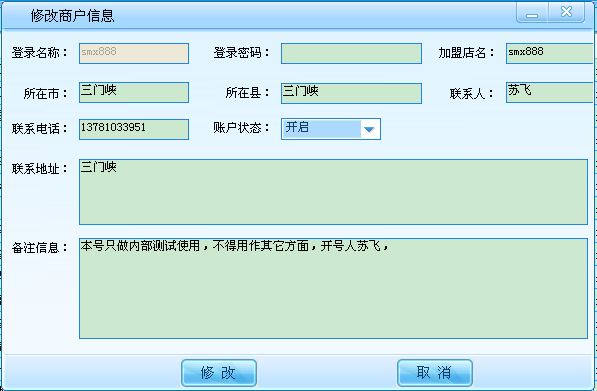导读部分
-------------------------------------------------------------------------------------------------------------
C#仿QQ皮肤-实现原理系列文章导航 最新版源码下载
http://www.cckan.net/thread-2-1-1.html
本次是我们窗体实现的最后一节,在这里首先感谢大家的支持,今天所说一个用户控件EnterFrom1和窗体EntryForm其实是分别继承自 基窗体FormBase与基用户控件FormBase1 而来的,而其中EnterFrom1是继承的用户控件EnterUserControl 这个控件而来,而EnterUserControl 又是继承的Formbase1而得来的,具体关于这个控件和窗体的实现请大家参考 相关的章节,而我们今天 要实现的两个小东东,其实是最简单, 因为在CS类里只要一行代码就OK了
实现的效果如下

EnterFrom1
{
public EnterFrom1()
{
InitializeComponent();
}
}
关键的代码就是第一行,继承一下EnterUserControl
这个用户控件就行了,而在InitializeComponent()方法中简单的数行代码就可以完全搞定了

 代码
代码
/// 设计器支持所需的方法 - 不要
/// 使用代码编辑器修改此方法的内容。
/// </summary>
private void InitializeComponent()
{
System.ComponentModel.ComponentResourceManager resources = new System.ComponentModel.ComponentResourceManager( typeof (EnterFrom1));
this .SuspendLayout();
//
// pnlBackGroup
//
this .pnlBackGroup.BackgroundImage = ((System.Drawing.Image)(resources.GetObject( " pnlBackGroup.BackgroundImage " )));
this .pnlBackGroup.Size = new System.Drawing.Size( 723 , 496 );
//
// EnterFrom1
//
this .AutoScaleDimensions = new System.Drawing.SizeF(6F, 12F);
this .AutoScaleMode = System.Windows.Forms.AutoScaleMode.Font;
this .Controls.Add( this .pnlBackGroup);
this .Name = " EnterFrom1 " ;
this .Size = new System.Drawing.Size( 723 , 496 );
this .Controls.SetChildIndex( this .pnlBackGroup, 0 );
this .ResumeLayout( false );
}
再来看一下EntryForm的实现 吧,CS类
{
public EntryForm()
{
InitializeComponent();
}
}
它的InitializeComponent()方法代码如下

 代码
代码
/// Required method for Designer support - do not modify
/// the contents of this method with the code editor.
/// </summary>
private void InitializeComponent()
{
System.ComponentModel.ComponentResourceManager resources = new System.ComponentModel.ComponentResourceManager( typeof (EntryForm));
this .SuspendLayout();
//
// ptbBottomMiddle
//
this .ptbBottomMiddle.BackgroundImage = ((System.Drawing.Image)(resources.GetObject( " ptbBottomMiddle.BackgroundImage " )));
this .ptbBottomMiddle.Size = new System.Drawing.Size( 951 , 37 );
//
// pnlBackGroup
//
this .pnlBackGroup.BackgroundImage = ((System.Drawing.Image)(resources.GetObject( " pnlBackGroup.BackgroundImage " )));
this .pnlBackGroup.Location = new System.Drawing.Point( 2 , 31 );
this .pnlBackGroup.Size = new System.Drawing.Size( 967 , 430 );
//
// EntryForm
//
this .AutoScaleDimensions = new System.Drawing.SizeF(6F, 12F);
this .AutoScaleMode = System.Windows.Forms.AutoScaleMode.Font;
this .ClientSize = new System.Drawing.Size( 971 , 498 );
this .Controls.Add( this .pnlBackGroup);
this .Location = new System.Drawing.Point( 400 , 300 );
this .Name = " EntryForm " ;
this .Text = " EntryForm " ;
this .Controls.SetChildIndex( this .pnlBackGroup, 0 );
this .ResumeLayout( false );
}
其实说白了这两个东西是一个实现原理不同只是一个是窗体,一个是用户控件 而已,其它的差不是很大,相信以后他们两个是用的最多的窗体和用户控件 ,只要大家使用一定会慢慢的深入了解它们的。
我们实现原理这一块的就到这里了,下次就要到我们的框架的搭建了,呵呵,在这一块才是皮肤的核心东西,讲的是怎么样实现颜色,就是皮肤的转换,和使用,他们是用什么样的方式来实现 的,在写的过程中我会一节一节的分析一下是怎么样实现的,我们都用到了那些GDI+方面的东西,用到了那些方面的Windows消息,和颜色和坐标的一些算法等等。




 本文详细解析了C#中窗体与用户控件的实现原理,通过EnterFrom1和EntryForm的例子展示了如何继承基类并使用InitializeComponent方法进行初始化。文章深入探讨了窗体和用户控件之间的区别,以及它们在实际应用中的使用场景。
本文详细解析了C#中窗体与用户控件的实现原理,通过EnterFrom1和EntryForm的例子展示了如何继承基类并使用InitializeComponent方法进行初始化。文章深入探讨了窗体和用户控件之间的区别,以及它们在实际应用中的使用场景。

















 36
36

 被折叠的 条评论
为什么被折叠?
被折叠的 条评论
为什么被折叠?








